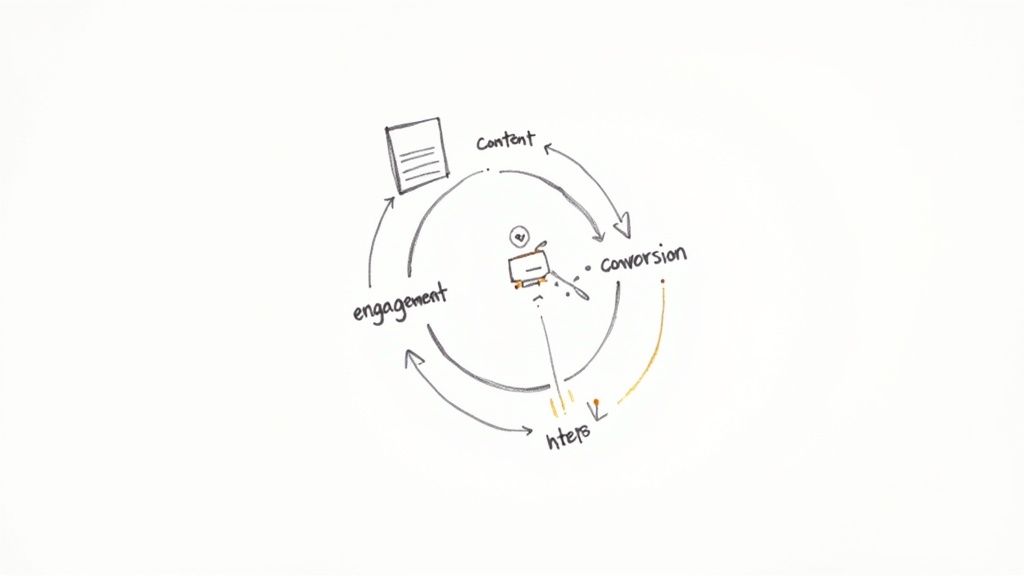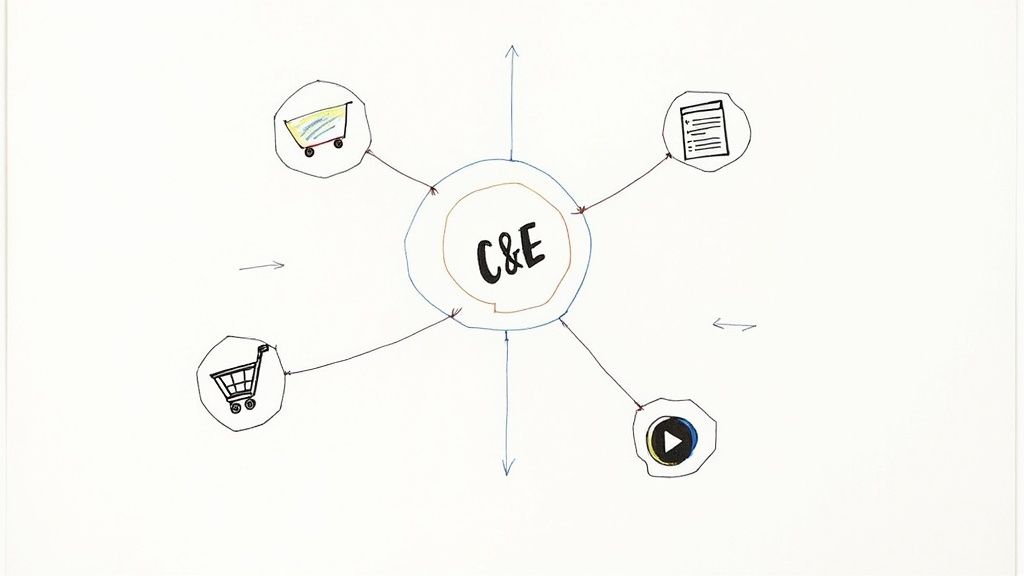Content and Ecommerce Success: Your Complete Strategy Guide

15 mins
6/17/2025
Joe Ervin
- content and ecommerce
- ecommerce strategy
- content marketing
- online sales
- digital commerce
Understanding Content and Ecommerce Integration
Imagine walking into a shop where every item tells a story. A place where you learn something new even if you don't buy anything, and where you feel understood, not just sold to. That's the magic of good content and ecommerce integration.
Many online stores still treat content like an afterthought – a blog hidden in the footer or generic product descriptions. But successful brands weave compelling narratives directly into the shopping experience, turning casual browsers into engaged customers.
This integration transforms the buyer's journey from a simple transaction into a relationship. We'll explore real-world examples of how brands use content to address customer problems, naturally guiding them towards purchases that feel right.
This shift is vital because customers actively seek richer, more personalized online experiences. In fact, this desire for engaging interactions fuels the e-commerce market's projected growth to $8.3 trillion by 2025, a 55.3% increase from 2021. Discover more insights about the e-commerce market here. With over 70% of purchases now happening on mobile, this trend is only accelerating.
How Integration Works
Think of content as the bridge between your brand's expertise and your customer's needs. It’s the conversation starter, the problem solver, and the foundation of trust. This goes beyond simply describing products; it's about providing real value.
For instance, a skincare brand might publish blog posts about different skin types, common issues, and effective solutions. This positions them as a knowledgeable resource, building trust and making customers more likely to buy their products.

This screenshot of Shopify's homepage shows their focus on helping businesses create smooth online experiences. The clean design and emphasis on features like marketing and sales tools demonstrate how platforms are facilitating this blend of content and commerce. You might be interested in: Content Marketing for E-commerce
Why Content Matters in E-commerce
Content acts as a magnet, drawing in potential customers searching for information related to your products. It's your first impression, the chance to show off your brand's personality and values.
Content also keeps customers returning. Regular blog posts, engaging social media activity, and email newsletters nurture relationships, turning one-time buyers into loyal fans. This ongoing connection builds a community around your brand, creating a sense of shared interest and belonging. Understanding this is key for sustained growth.
The Evolution of Digital Shopping Experiences

This screenshot from Amazon's homepage shows how content is woven into a platform primarily focused on selling. Think personalized recommendations, curated lists, and featured deals – all content gently guiding the user experience. The blend of product displays, promotional banners, and informational snippets shows how Amazon uses content to help people discover products and, ultimately, buy them.
Remember the early days of ecommerce? Websites were like online catalogs – rows of static product listings with bare-bones descriptions. But things have changed. Smartphones, social media, and rising customer expectations have completely reshaped digital shopping. This shift has redefined how content and ecommerce work together. Today's online brands understand: shopping is an experience, not just a click-and-buy transaction.
From Transaction to Relationship
Successful ecommerce brands now create digital experiences that feel more like having a personal shopping assistant. Imagine a knowledgeable friend guiding you through a carefully curated showroom, anticipating your needs and offering just the right information. This isn't about simply adding more content; it's about strategically integrating content and commerce to create experiences that inform, inspire, and, yes, convert.
Think about the difference between a generic product description and a blog post that explains how that same product solves a real customer problem. The blog post builds trust, positions the brand as an expert, and empowers the customer to make an informed purchase decision.
This approach works because it speaks to what today’s consumers want. Bombarded with endless marketing messages, they value authenticity. Brands that offer this through valuable, engaging content are the ones winning.
The Power of Storytelling in Ecommerce
Thanks to social media, storytelling is now a core part of marketing. Customers expect brands to engage them with compelling narratives, not just dry product features. This means weaving stories directly into the shopping experience itself.
Plus, with smartphones putting the internet in everyone's pocket, brands must create mobile-friendly content experiences. Customers now expect the same level of engagement and personalization on their phones as they do on their desktops.
This evolving landscape is a growing market, too. Retail ecommerce sales are expected to hit $6.42 trillion in 2025, a 6.86% increase from 2024. This growth underscores how vital ecommerce has become. Learn more about this growth here. As ecommerce expands, understanding how content and commerce work together is even more important for success. Brands that focus on content-driven experiences will have a major competitive edge.
To illustrate this further, let's compare traditional ecommerce tactics with modern content-integrated strategies:
The following table provides a comparison between traditional ecommerce approaches and the modern content-integrated approach, highlighting the difference in customer experience.
Traditional vs Content-Integrated Ecommerce Approaches Comparison of old-school ecommerce tactics versus modern content-integrated strategies
| Traditional Ecommerce | Content-Integrated Ecommerce | Impact on Customer Experience |
|---|---|---|
| Focus on product listings and promotions | Focus on valuable content that educates and engages | Builds trust and fosters a deeper connection with the brand |
| Generic product descriptions | Detailed product information, blog posts, videos, and user-generated content | Empowers customers to make informed purchase decisions |
| Static website experience | Interactive and personalized experiences | Creates a more engaging and enjoyable shopping journey |
| One-way communication (brand to customer) | Two-way communication and community building | Fosters brand loyalty and advocacy |
| Short-term sales focus | Long-term relationship building | Increases customer lifetime value |
In short, while traditional ecommerce was transactional, content-integrated ecommerce is relational. It’s about building connections, not just closing sales. This shift is driving customer engagement, loyalty, and ultimately, greater success for brands that embrace it.
Core Frameworks for Content and Ecommerce Success
Let's be honest, simply adding more blog posts to your website won't magically boost sales. Successful brands use strategic frameworks, much like a builder uses blueprints, to align content with customer journeys and business goals.
The Content-Commerce Flywheel
Imagine a flywheel. The Content-Commerce Flywheel works similarly. Good content draws in potential customers. Engaging experiences build trust, leading to purchases. Happy customers then share their experiences, boosting your content and spinning the flywheel faster, attracting even more customers. It's a self-sustaining cycle of growth.
The Staged Content Strategy
Customers don't just buy; they journey through stages: awareness, consideration, and decision. The Staged Content Strategy uses different content for each. Blog posts and social media might spark awareness, while product comparisons and reviews aid consideration. Finally, targeted offers and testimonials can seal the deal.
The Omnichannel Content Framework
Think of the customer journey as a conversation. The Omnichannel Content Framework keeps your brand message consistent across platforms – social media, email, your website, even offline. This cohesive experience builds brand recognition and trust, making a purchase feel like a natural next step in the conversation.

This screenshot from Klaviyo's website showcases personalized email marketing, a vital part of content and ecommerce integration. Klaviyo uses data to tailor emails, driving engagement and conversions. This demonstrates how email, within a content-integrated strategy, can be a powerful ecommerce tool.
Putting Frameworks into Practice
These frameworks aren't just theories. They're practical tools that real brands use to create cohesive, conversion-focused experiences. Companies that blog regularly see 50% more traffic than those that don't. Integrating these frameworks turns your online store into a vibrant destination that attracts and retains customers.
To illustrate how these frameworks translate into specific actions, let’s take a look at how different content types can be mapped to the customer journey.
Let's take a look at the table below to get a clearer picture:
Content Types by Customer Journey Stage: Mapping optimal content formats to different stages of the ecommerce customer journey
| Journey Stage | Content Type | Primary Goal | Success Metrics |
|---|---|---|---|
| Awareness | Blog posts, Social media updates, Infographics | Generate interest and drive traffic to your website | Website traffic, Social media engagement, Brand mentions |
| Consideration | Product comparisons, Reviews, Case studies, Webinars | Educate potential customers about your products/services | Time on page, Lead generation, Download rates |
| Decision | Targeted offers, Customer testimonials, Free trials, Demos | Convert prospects into paying customers | Conversion rates, Sales, Average order value |
This table shows how different types of content can be strategically used at each stage of the customer journey. From initial awareness to final purchase, the right content can guide potential customers towards becoming loyal brand advocates.
By understanding how each stage influences customer behavior, you can create a more effective content strategy that drives results.
Essential Content Types That Drive Ecommerce Results
Not all content is created equal when it comes to selling online. Some types are simply more effective at building customer trust, answering their questions, and ultimately, leading them to click that "buy" button. High-converting content goes beyond simply describing products; it delves into solving problems and sharing relatable stories. Think of it this way: product storytelling takes dry specifications and weaves them into captivating narratives that help customers visualize themselves using your products. Meanwhile, user-generated content (UGC) provides genuine endorsements from real people, and educational content positions your brand as a helpful expert rather than just another pushy salesperson.
Product Storytelling: Beyond the Specs
Imagine visiting a furniture website that only lists dimensions and materials. Pretty dull, right? Now, picture landing on a page that shows families gathered around that same furniture, laughing and making memories. That's the magic of product storytelling. It connects with emotions and aspirations, showing customers how a product can truly enhance their lives. This approach creates a deeper connection that goes far beyond a simple transaction.
The Power of User-Generated Content
Consider how much more inclined you are to purchase a product after reading positive reviews. User-generated content provides that same social proof, but amplified. Whether it's customer photos showcasing your products, video testimonials, or reviews shared on social media platforms like Instagram or Facebook, UGC builds authenticity and fosters trust. It demonstrates to potential buyers that real people enjoy your products, encouraging them to make a purchase themselves.
Educating and Empowering Your Audience
Offering valuable educational content transforms your brand into a trusted advisor. This could take the form of blog posts, videos, how-to guides, or even engaging interactive quizzes. The key is to offer genuinely helpful information related to your products, without resorting to aggressive sales tactics. This approach builds a positive relationship with your audience and makes them more open to your offerings. They begin to see you as a valuable resource, not just a retailer. Companies that regularly publish blog content often see 50% more website traffic than those that don't, highlighting the power of content to attract and engage potential customers.
Integrating Content Seamlessly
One of the biggest mistakes brands make is creating content in isolation. Effective content and ecommerce integration means weaving these formats into a unified customer experience. Every piece of content should feel like a natural part of a larger, ongoing conversation.

This screenshot from Glossier's website perfectly illustrates how user-generated content and product storytelling can be seamlessly integrated. The emphasis on real people and their positive experiences with Glossier products fosters a sense of community and authenticity, driving engagement and influencing purchase decisions. Glossier masterfully combines user-generated content and brand storytelling to create a truly engaging ecommerce experience. For a more in-depth look at developing a strong ecommerce content strategy, explore our guide on building a successful ecommerce content strategy. By strategically integrating your content, you can build a compelling and effective ecommerce experience that drives both traffic and conversions.
Implementation Strategies and Best Practices
Imagine planning a road trip. Knowing your destination is just the beginning. You need a map, a reliable car, and the flexibility to handle unexpected detours. Building a successful content and ecommerce integration is similar. It requires careful planning and the ability to adapt. This section is your roadmap – a guide to auditing your current setup, finding quick wins, and creating long-term strategies for an exceptional customer experience.
Auditing Your Content and Ecommerce Landscape
The first step is taking stock of where you stand. This means conducting a thorough audit of your existing content and ecommerce systems. Ask yourself key questions: What content do you have? Does it resonate with your target audience and support your business goals? Where are the gaps in your content strategy? Are your teams collaborating effectively, or are there communication roadblocks? Look for workflow inefficiencies that slow down content production. This honest evaluation forms the basis of your integration strategy.
Identifying Quick Wins and Building Momentum
Once you've pinpointed areas for improvement, aim for some quick wins. These early victories build momentum and demonstrate the value of integration. For example, if your product descriptions are bland, rewriting them with compelling stories and focusing on customer benefits can have a big impact. Another quick win? Incorporate user-generated content like customer reviews. This boosts social proof and can increase conversions without a huge investment. These initial successes generate enthusiasm and pave the way for more involved projects.
Developing Long-Term Strategic Initiatives
Building on your quick wins, develop long-term strategies that reshape the entire customer experience. This means establishing clear processes for content creation, distribution, and measurement. Think about creating a content calendar aligned with your marketing campaigns and product launches. Set up a system for gathering and showcasing user-generated content. Explore tools that automate content distribution across different channels. These initiatives will ensure your content and ecommerce integration remains strong over time.
This screenshot from Contentful's website highlights their focus on content infrastructure, a vital component of successful integration. Features like structured content, APIs, and omnichannel delivery show how platforms are adapting to support complex content needs. Contentful exemplifies how dedicated platforms can facilitate smooth integration of content into the ecommerce experience.
Addressing Common Implementation Challenges
Integrating content and ecommerce comes with its own set of hurdles. Maintaining a consistent brand voice across all platforms is essential. Your content, whether on your website, social media, or in email campaigns, should reflect your brand’s personality and values. Another challenge is balancing educational content with conversion goals. Providing valuable information builds trust, but you also need to guide customers towards purchasing. Measuring the success of integrated campaigns can be tricky. Attribution isn't always straightforward. Using analytics tools and defining clear KPIs helps you track how content influences customer behavior and optimize accordingly.
Real-World Success Stories and Case Studies
Sometimes, the best way to grasp a concept like content and ecommerce integration is to see how it plays out in the real world. Let's explore how different brands, from fresh startups to well-established retailers, have used content to reshape their online presence and achieve tangible business results.
Beauty Brand Sees Significant Lift in Average Order Value
Imagine browsing for a new serum. You see the usual product details, sure, but then you also discover a short video demonstrating how to use it, along with articles explaining the key ingredients and their benefits. One beauty brand adopted this exact approach, transforming their product pages into valuable resources. The result? A 40% jump in average order value. By providing helpful content alongside product information, they boosted customer confidence and encouraged larger purchases.
Home Goods Company Slashes Acquisition Costs
Attracting new customers can be expensive, but one home goods company found a clever way to reduce those costs. They focused on creating informative blog posts and guides about interior design trends and home improvement tips. This strategy drew organic traffic from search engines like Google, lessening their dependence on pricey paid advertising. They achieved a 35% reduction in customer acquisition costs, proving the power of content to attract and engage potential customers without breaking the bank. For a deeper dive into attracting and retaining customers, you might find this helpful: understanding the ecommerce customer journey.
Fashion Retailer Nurtures Customer Lifetime Value
Personalized experiences are key to building lasting customer relationships. A fashion retailer took this to heart by crafting personalized content. Think about receiving emails showcasing new arrivals based on your past purchases and style preferences, or discovering blog posts with outfits curated just for your body type. This retailer used this strategy to increase customer lifetime value. By keeping customers engaged long after their initial purchase, they fostered loyalty and encouraged repeat business.
Warby Parker: A Prime Example of Content-Driven Commerce
Take a look at this screenshot from Warby Parker's website. It perfectly illustrates their focus on blending content seamlessly with ecommerce. They offer detailed guides on selecting the right frames, virtual try-on tools, and even a blog discussing eyewear trends and eye health. Warby Parker effectively uses content to educate customers, turning the buying process into a more engaging and informed experience.
Key Takeaways from These Success Stories
These aren't just feel-good stories; they offer practical lessons. They underscore the importance of strategic content integration, focusing on the customer journey, and measuring success beyond just sales numbers. These brands show that content and ecommerce, when combined effectively, create a powerful synergy that fuels sustainable growth. They illustrate that modern shopping is as much about the narrative as it is about the product itself. Providing value, building trust, and crafting engaging experiences that connect with today's informed consumers are paramount. These success stories provide a roadmap for brands looking to elevate their online presence and achieve similar results. They demonstrate the fact that businesses that blog regularly experience 50% more traffic compared to those that don't, highlighting content's power in attracting potential customers.
Measuring Success and Optimizing Performance
Figuring out the real impact of connecting your content and ecommerce efforts can be tricky. It's not enough to just look at the usual suspects like conversion rate and average order value. Those are important, sure, but they're only pieces of the puzzle. We need to dig deeper and see how content influences customers throughout their entire buying journey. And that journey can be winding, touching multiple points over weeks or even months.
Establishing Meaningful KPIs
Think of your metrics like a compass, guiding your content and ecommerce strategy. You'll need both leading indicators and lagging indicators. Leading indicators offer clues about what might happen in the future. Think of things like engagement, time spent on the site, and how much content people are actually consuming. These metrics show what's catching your audience's eye and can hint at future success.
Lagging indicators, on the other hand, show the final results. These are your sales figures, customer lifetime value, and retention rates. They measure the ultimate impact of your content on your profits. The sweet spot lies in balancing these two types of metrics. For example, if people are spending a lot of time on blog posts about a certain product line, that might signal strong interest and predict a sales boost down the road.
Attribution Models: Connecting Content to Conversions
Let's say a customer first hears about your brand from a blog post about sustainable fashion. Weeks later, they buy a dress after clicking a Facebook ad. How do you give credit where credit is due? That's where attribution models step in. They help you track how your content influences purchases, even when the final sale happens somewhere else.
Different models weigh touchpoints differently. A last-click attribution model would credit the Facebook ad, while a first-click attribution model would point to the blog post. More nuanced models, like linear attribution or time-decay attribution, spread the credit across every touchpoint. Picking the right model really depends on your unique business goals.
Advanced Optimization Techniques
Once you've nailed down your KPIs and attribution model, you can start fine-tuning your content and ecommerce experience for even better results. Multivariate testing lets you try out different versions of your content-commerce setup. Think different product page layouts, calls to action, or even the language you use in product descriptions. This helps pinpoint the most effective variations and boost conversions.
Personalization is another powerful tool. By tailoring content and product suggestions to each customer's tastes, you can make things more relevant and encourage purchases.
This screenshot from Google Analytics shows how the platform tracks website traffic and user behavior. Metrics like page views, bounce rate, and average session duration offer valuable insights into content performance. Analyzing these metrics reveals what's working, what content leads to sales, and where you can improve. These findings can guide adjustments to your content strategy and the overall user experience.
Data Analysis: Uncovering Hidden Opportunities
Going beyond the usual metrics, data analysis can uncover surprising opportunities. For example, you might find that a certain demographic loves your blog content but rarely buys anything. This could lead to targeted marketing campaigns or personalized content specifically crafted for that group.
Cohort analysis is another insightful technique. It lets you follow the behavior of customer groups over time, revealing trends in customer lifetime value, churn rates, and the long-term impact of your strategies. By constantly analyzing your data, you can identify areas for improvement and ensure your efforts are genuinely growing your business. This ongoing optimization is essential for staying competitive and achieving long-term success in the ever-changing world of content and ecommerce.





